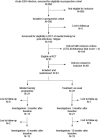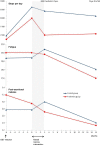Cognitive-behavioural therapy combined with music therapy for chronic fatigue following Epstein-Barr virus infection in adolescents: a feasibility study
- PMID: 32342016
- PMCID: PMC7173952
- DOI: 10.1136/bmjpo-2019-000620
Cognitive-behavioural therapy combined with music therapy for chronic fatigue following Epstein-Barr virus infection in adolescents: a feasibility study
Retraction in
-
Retraction: Cognitive-behavioural therapy combined with music therapy for chronic fatigue following Epstein-Barr virus infection in adolescents: a feasibility study.BMJ Paediatr Open. 2020 Oct 21;4(1):e000620ret. doi: 10.1136/bmjpo-2019-000620ret. eCollection 2020. BMJ Paediatr Open. 2020. PMID: 33123631 Free PMC article.
Abstract
background: Cognitive-behavioural therapy (CBT) is effective in chronic fatigue syndrome. However, CBT has not been investigated in postinfectious chronic fatigue (CF), nor is it known whether addition of therapeutic elements from other disciplines might be feasible. We studied the feasibility of a combined CBT and music therapy intervention for CF following Epstein-Barr virus (EBV) infection in adolescents.
methods: Adolescents (12-20 years old) participating in a postinfectious cohort study who developed CF 6 months after an acute EBV infection were eligible for the present feasibility study. A combined CBT and music therapy programme (10 therapy sessions and related homework) was compared with care as usual in a randomised controlled design. Therapists and participants were blinded to outcome evaluation. Endpoints included physical activity (steps/day), symptom scores, recovery rate and possible harmful effects, but the study was underpowered regarding efficacy. Total follow-up time was 15 months.
results: A total of 43 individuals with postinfectious CF were included (21 intervention group, 22 control group). Seven individuals left the study during the first 3 months, leaving 15 in the intervention group and 21 in the control group at 3 months' follow-up. No harmful effects were recorded, and compliance with appointment was high. In intention-to-treat analyses, number of steps/day tended to decrease (difference=-1158, 95% CI -2642 to 325), whereas postexertional malaise tended to improve (difference=-0.4, 95% CI -0.9 to 0.1) in the intervention group at 3 months. At 15 months' follow-up, there was a trend towards higher recovery rate in the intervention group (62% vs 37%).
conclusion: An intervention study of combined CBT and music therapy in postinfectious CF is feasible, and appears acceptable to the participants. The tendencies towards positive effects on patients' symptoms and recovery might justify a full-scale clinical trial.
trial registration number: NCT02499302.
Keywords: Epstein-Barr virus infection; adolescents; chronic fatigue; chronic fatigue syndrome; cognitive–behavioural therapy; music therapy.
© Author(s) (or their employer(s)) 2020. Re-use permitted under CC BY-NC. No commercial re-use. See rights and permissions. Published by BMJ.
Conflict of interest statement
Competing interests: None declared.
Figures



Similar articles
-
Cognitive-behavioural therapy combined with music therapy for chronic fatigue following Epstein-Barr virus infection in adolescents: a randomised controlled trial.BMJ Paediatr Open. 2020 Oct 21;4(1):e000797. doi: 10.1136/bmjpo-2020-000797. eCollection 2020. BMJ Paediatr Open. 2020. PMID: 33117895 Free PMC article.
-
Clinical symptoms and markers of disease mechanisms in adolescent chronic fatigue following Epstein-Barr virus infection: An exploratory cross-sectional study.Brain Behav Immun. 2019 Aug;80:551-563. doi: 10.1016/j.bbi.2019.04.040. Epub 2019 Apr 27. Brain Behav Immun. 2019. PMID: 31039432
-
Pain in adolescent chronic fatigue following Epstein-Barr virus infection.Scand J Pain. 2020 Oct 25;20(4):765-773. doi: 10.1515/sjpain-2020-0031. Scand J Pain. 2020. PMID: 32892183
-
Behavioural modification interventions for medically unexplained symptoms in primary care: systematic reviews and economic evaluation.Health Technol Assess. 2020 Sep;24(46):1-490. doi: 10.3310/hta24460. Health Technol Assess. 2020. PMID: 32975190 Free PMC article.
-
[A group cognitive behavioral intervention for people registered in supported employment programs: CBT-SE].Encephale. 2014 Jun;40 Suppl 2:S81-90. doi: 10.1016/j.encep.2014.04.005. Epub 2014 Jun 16. Encephale. 2014. PMID: 24948482 Review. French.
References
-
- Hickie I, Davenport T, Wakefield D, et al. . Post-infective and chronic fatigue syndromes precipitated by viral and non-viral pathogens: prospective cohort study. BMJ 2006;333:575. 10.1136/bmj.38933.585764.AE - DOI - PMC - PubMed
-
- IOM Institute of medicine Beyond myalgic Encephalomyelitis/Chronic fatigue syndrome: redefining an illness. Washington, DC: The National Academies Press, 2015. http://www.iom.edu/mecfs - PubMed
-
- Royal College of Paediatrics and Child Health Evidence based guidelines for the management of CFS/ME (chronic fatigue syndrome/myalgic encephalopathy) in children and young adults. London: Royal College of Paediatrics and Child Health, 2004.
Publication types
Associated data
LinkOut - more resources
Full Text Sources
Medical
